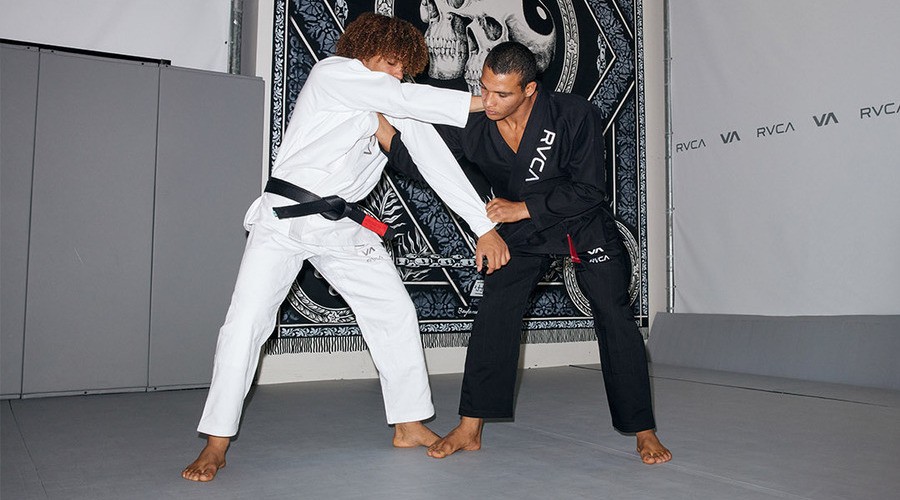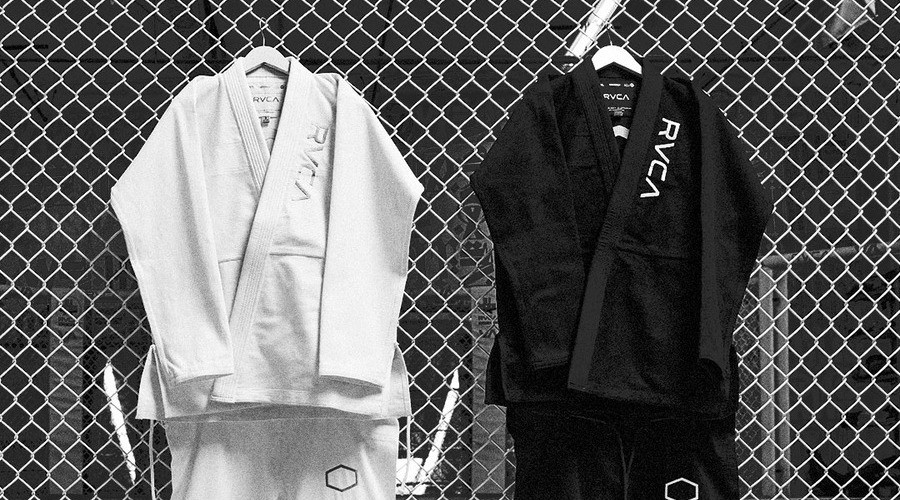
The jiu jitsu kimono, more commonly known as a gi, represents the dedication and discipline associated with the sport of BJJ. In this guide, we’ll cover the factors to consider when choosing the right gi size and requirements for your type of training.

The word “gi” means “clothes” in Japanese. In Brazilian jiu jitsu, a gi is the robe-style top and drawstring pants that make up the discipline’s formal uniform.
A jiu jitsu gi differs from gis (or kimonos) in other disciplines. To withstand the grappling and physical contact in jiu jitsu, the BJJ gi is thicker and more durable than the robe worn in karate, but is more fitted, lightweight and flexible than the gis used for Judo competitions.
Jiu jitsu success is heavily based on flexibility and your ability to grapple or escape from holds, and an improperly fitted gi could restrict your movement and ability to compete.
Many jiu jitsu organizations have specific rules concerning the fit of your gi, and you’ll want to keep them in mind as you shop. Here are a few tips to help you find a good fit once you know your organization's rules.
BJJ gi sizing is noted using an A0 through A6 system. The letter in this system indicates who the gi is for. A (for adult) is for men or general adult sizing. Gis for children feature a Y (for youth), and gis for women feature a W. All sizes correspond to the heights and weights of athletes.
| Size | Height | Weight |
|---|---|---|
| A0 | 5’0” – 5’4” (152 – 163 cm) | 110 – 145 lbs (50 – 66 kgs) |
| A1 | 5’4” – 5’8” (163 – 173 cm) | 130 – 165 lbs (60 – 75 kgs) |
| A2 | 5’8” – 5’11” (173 – 180 cm) | 165 – 195 lbs (75 – 88 kgs) |
| A3 | 5’11” – 6’2” (180 – 188 cm) | 195 – 225 lbs (88 – 102 kgs) |
| A4 | 6’2” – 6’4” (188 – 193 cm) | 225 – 250 lbs (102 – 113 kgs) |
| A5 | 6’4” – 6’6” (193 – 198 cm) | 250 – 280 lbs (113 – 127 kgs) |
| A6 | 6’6” (198 cm) + | 280 lbs (127 kgs) + |
Gis are also available in “in-between” and specialty sizes, including long (L), fitted (F) or slim (S), and husky (H) or wide (W) fits. If you fall between sizes, check the garment dimensions to help you determine sleeve and pant lengths that reach your wrists and ankles.

Women’s gis are sized in W0-W6. Double check with your manufacturer if “W” stands for “women” or “wide”, as it may differ across brands. Women’s sizing will also feature tall, slim, and wide fits to ensure a fit that works with your performance.
| Size | Height | Weight |
|---|---|---|
| W0 | 4’10” – 4’11” (145 – 150 cm) | 75 – 95 lbs (35 – 43 kgs) |
| W1 | 4’11” – 5’1” (150 – 155 cm) | 95 – 120 lbs (43 – 55 kgs) |
| W2 | 5’1” – 5’4” (155 – 163 cm) | 120 – 135 lbs (55 – 60 kgs) |
| W3 | 5’4” – 5’8” (163 – 173 cm) | 135 – 148 lbs (60 – 67 kgs) |
| W4 | 5’8” – 5’11” (173 – 180 cm) | 148 – 160 lbs (67 – 73 kgs) |
| W5 | 5’11” – 6’1” (180 – 185 cm) | 160 – 172 lbs (73 – 78 kgs) |
| W6 | 6’1” (185 cm) + | 172 lbs (78 kg) +/td> |
During training, the fit requirements for your gi are more relaxed in fit and length when compared to competition gis. A training gi tends to be thicker in construction so that it can endure many training sessions.


There are a variety of jiu jitsu styles and approaches. Combat and pressure-based styles will call for a thicker, more durable gi to prevent rips or tears that could disqualify you from a competition. Passing, self-defense, and striking-based jiu jitsu practices require a more lightweight gi for quick and free-flowing movement.
Like in competitions, white, black, or blue gis are common colors for training. For beginners, a solid white or black gi will ensure you have a suitable gi color no matter where you workout.
Gis are either 100% cotton or constructed from cotton blended with nylon or polyester. Some gis also come pre-shrunk. Always check the care instructions on your gi to keep it in the best condition possible.

In addition to choosing a quality gi, your care routine can help extend your gi’s lifespan. Check out our dedicated article on “How To Wash and Care for Your JJ Gi” to keep your gi in top condition for longer.

Gi collars are usually filled with cotton or rubber. While cotton collars tend to accompany lighter-weight gis, these are easy for your opponent to grab. Rubber collars are more durable but can sometimes feel rough or uncomfortable. Your jiu jitsu organization might have specific rules regarding collar width, so check the regulations first.
Jiu jitsu gis come in fitted or loose pant styles. Choose pants that allow for comfortable movement and reach your ankles to ensure fit compliance.
While gis are an essential element to your jiu jitsu practice, they come with a variety of features and in many fits and styles. Start by researching the rules of your gym or competition then use personal preference and training level to decide which one is right for you.
Moisture Wicking Clothing Benefits
How To Care for Your Workout Clothes
How To Choose Compression Rashguards
How To Choose Compression Shorts